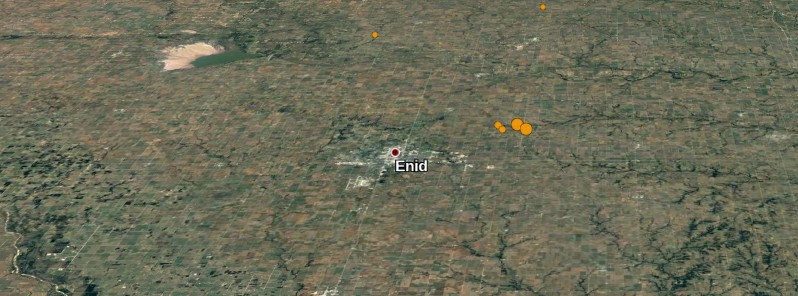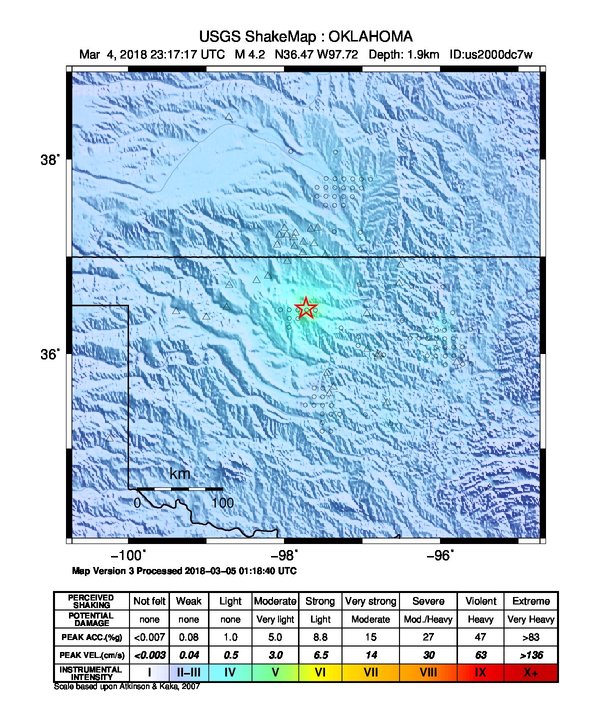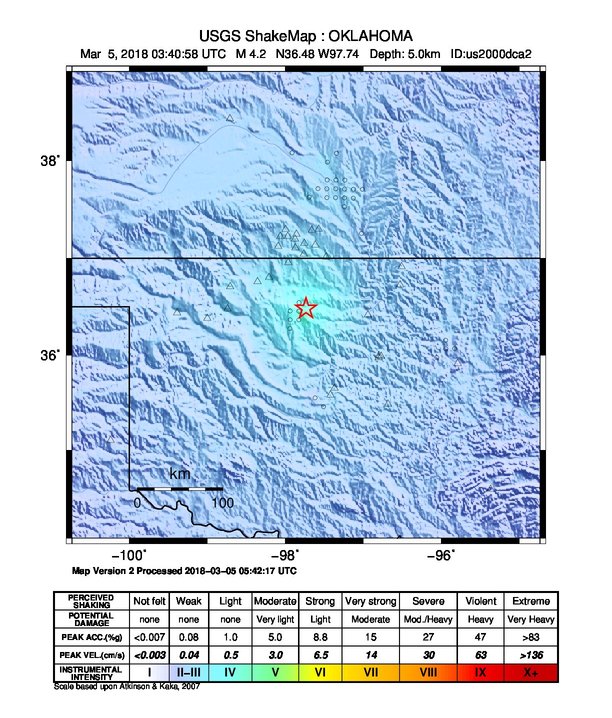Two damaging M4.2 earthquakes hit NE of Enid, Oklahoma

Two damaging M4.2 earthquakes were registered 16 km (9.9 miles) ENE of Enid, Oklahoma on March 4 and 5, 2018.
The first hit at 23:17 UTC on March 4 at a depth of 1.9 km (1.18 miles) and was followed by another M4.2 at 03:40 UTC on March 5 at a depth of 5 km (3.1 miles). The same area was hit by M2.7 at 06:35 UTC and M2.6 at 12:16 UTC on March 5.
USGS reported epicenters 3.5 km (2.2 miles) N of Breckinridge (population 245), 16 km (9.9 miles) ENE of Enid (population 51 776), 63 km (39.2 miles) WSW of Ponca City (population 24 758) and 112.6 km (70 miles) N of Oklahoma City (population 631 346).

Some 1 000 people are estimated to have felt moderate, 73 000 light and 5 122 000 weak shaking associated with the first M4.2 earthquake (depth 1.9 km (1.18 miles)). 64 000 people are estimated to have felt light and 5 146 000 weak shaking associated with the second M4.2 quake (depth 5 km (3.1 miles)). 
At least one home in Breckenridge had major brick separation from doors and windows following the first quake, Enid and Garfield County Emergency Management Director Mike Honigsberg said. There were also structural issues with sheetrock cracking above doors and windows, and some stairstep cracking in some areas of brick, he said. "The home appeared to be safe enough to stay in, but a structural engineer will need to evaluate it."
Honigsberg advised that anyone living within at least 8 km (5 miles) of the epicenter should check for damage and contact their insurance agent if there is damage.
The strongest quake in the history of Oklahoma is September 3, 2016 M5.8, 15 km (9.3 miles) NW of Pawnee. Immediately after the quake, state authorities shut down 37 wastewater wells used by the fracking industry to extract oil and gas.
The USGS Geophysicist Daniel McNamara said at the time that the earthquake was not on a fault known by the USGS. Instead, it happened on a fault perpendicular which intersected the fault. Based on aftershock patterns, this one is an unknown fault that has now been activated.
"Aftershocks from that earthquake show the undiscovered fault line that runs near or through Stillwater, Oklahoma," McNamara said.
Animation of earthquakes in Oklahoma between 2004 and 2016
Many studies have investigated the relationship between seismic activity and wastewater injection, particularly in Oklahoma where scientists recorded a 4 000 % increase in the rate of earthquakes between 2008 and 2016.
The animation below, produced by the USGS Oklahoma shows all recorded earthquakes between 2004 and 2016. The size of the dots and volumes are proportional to earthquake strengths.

Earthquakes in the stable continental region
Natural occurring earthquake activity
Most of North America east of the Rocky Mountains has infrequent earthquakes. Here and there earthquakes are more numerous, for example in the New Madrid seismic zone centered on southeastern Missouri, in the Charlevoix-Kamouraska seismic zone of eastern Quebec, in New England, in the New York – Philadelphia – Wilmington urban corridor, and elsewhere. However, most of the enormous region from the Rockies to the Atlantic can go years without an earthquake large enough to be felt, and several U.S. states have never reported a damaging earthquake.
Earthquakes east of the Rocky Mountains, although less frequent than in the West, are typically felt over a much broader region than earthquakes of similar magnitude in the west. East of the Rockies, an earthquake can be felt over an area more than ten times larger than a similar magnitude earthquake on the west coast. It would not be unusual for a magnitude 4.0 earthquake in eastern or central North America to be felt by a significant percentage of the population in many communities more than 100 km (60 mi) from its source. A magnitude 5.5 earthquake in eastern or central North America might be felt by much of the population out to more than 500 km (300 mi) from its source. Earthquakes east of the Rockies that are centered in populated areas and large enough to cause damage are, similarly, likely to cause damage out to greater distances than earthquakes of the same magnitude centered in western North America.
Most earthquakes in North America east of the Rockies occur as faulting within bedrock, usually miles deep. Few earthquakes east of the Rockies, however, have been definitely linked to mapped geologic faults, in contrast to the situation at plate boundaries such as California's San Andreas fault system, where scientists can commonly use geologic evidence to identify a fault that has produced a large earthquake and that is likely to produce large future earthquakes. Scientists who study eastern and central North America earthquakes often work from the hypothesis that modern earthquakes occur as the result of slip on preexisting faults that were formed in earlier geologic eras and that have been reactivated under the current stress conditions. The bedrock of Eastern North America is, however, laced with faults that were active in earlier geologic eras, and few of these faults are known to have been active in the current geologic era. In most areas east of the Rockies, the likelihood of future damaging earthquakes is currently estimated from the frequencies and sizes of instrumentally recorded earthquakes or earthquakes documented in historical records.
Induced seismicity
As is the case elsewhere in the world, there is evidence that some central and eastern North America earthquakes have been triggered or caused by human activities that have altered the stress conditions in earth's crust sufficiently to induce faulting. Activities that have induced felt earthquakes in some geologic environments have included impoundment of water behind dams, injection of fluid into the earth's crust, extraction of fluid or gas, and removal of rock in mining or quarrying operations. In much of eastern and central North America, the number of earthquakes suspected of having been induced is much smaller than the number of natural earthquakes, but in some regions, such as the south-central states of the U.S., a significant majority of recent earthquakes are thought by many seismologists to have been human-induced. Even within areas with many human-induced earthquakes, however, the activity that seems to induce seismicity at one location may be taking place at many other locations without inducing felt earthquakes. In addition, regions with frequent induced earthquakes may also be subject to damaging earthquakes that would have occurred independently of human activity. Making a strong scientific case for a causative link between a particular human activity and a particular sequence of earthquakes typically involves special studies devoted specifically to the question. Such investigations usually address the process by which the suspected triggering activity might have significantly altered stresses in the bedrock at the earthquake source, and they commonly address the ways in which the characteristics of the suspected human-triggered earthquakes differ from the characteristics of natural earthquakes in the region. (USGS)
Featured image credit: USGS

This is not a celestrial being causing the quakes as the person in the video claims. It is from fracking for oil. The Watchers should know better.
Exactly. Wrong video was embedded. The original published by USGS is no longer available.